Attached files
| file | filename |
|---|---|
| 8-K - 8-K - CAPRICOR THERAPEUTICS, INC. | tv481633_8k.htm |
Exhibit 99.1

NASDAQ: CAPR December 2017

Forward - Looking Statements 2 Statements in this presentation regarding the efficacy, safety, and intended utilization of Capricor's product candidates ; the initiation, conduct, size, timing and results of discovery efforts and clinical trials ; the pace of enrollment of clinical trials ; plans regarding regulatory filings, future research and clinical trials ; regulatory developments involving products, including the ability to obtain regulatory approvals or otherwise bring products to market ; plans regarding current and future collaborative activities and the ownership of commercial rights ; scope, duration, validity and enforceability of intellectual property rights ; future royalty streams, expectations with respect to the expected use of proceeds from the recently completed offerings and the anticipated effects of the offerings, and any other statements about Capricor's management team's future expectations, beliefs, goals, plans or prospects constitute forward - looking statements within the meaning of the Private Securities Litigation Reform Act of 1995 . Any statements that are not statements of historical fact (including statements containing the words "believes," "plans," "could," "anticipates," "expects," "estimates," "should," "target," "will," "would" and similar expressions) should also be considered to be forward - looking statements . There are a number of important factors that could cause actual results or events to differ materially from those indicated by such forward - looking statements . More information about these and other risks that may impact Capricor's business is set forth in Capricor's Annual Report on Form 10 - K for the year ended December 31 , 2016 as filed with the Securities and Exchange Commission on March 16 , 2017 , in its Registration Statement on Form S - 3 , as filed with the Securities and Exchange Commission on September 28 , 2015 , together with the prospectus included therein and prospectus supplements thereto, and in its Quarterly Report on Form 10 - Q for the quarter ended September 30 , 2017 , as filed with the Securities and Exchange Commission on November 14 , 2017 . All forward - looking statements in this press release are based on information available to Capricor as of the date hereof, and Capricor assumes no obligation to update these forward - looking statements .

Investment Highlights ‒ Pipeline focused on rare pediatric disorders for which current options are inadequate ‒ Clinical proof - of - concept in lead indication – Duchenne muscular dystrophy ▪ To initiate potential registration trial in 1Q18 ▪ $1B+ U.S. sales opportunity ▪ Capricor holds worldwide IP rights ‒ Novel cell / exosome platform may address several challenging diseases ‒ Scalable manufacturing process in development ‒ Significant ownership by insiders 3
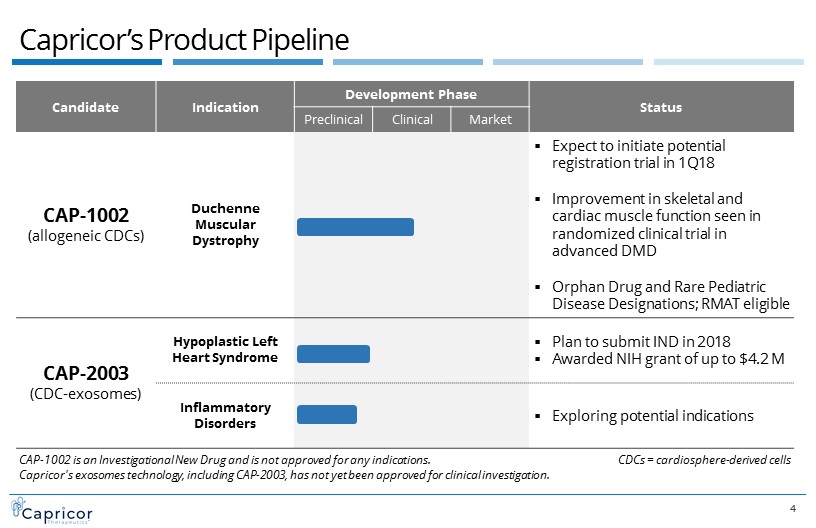
Capricor’s Product Pipeline 4 Candidate Indication Development Phase Status Preclinical Clinical Market CAP - 1002 (allogeneic CDCs) Duchenne Muscular Dystrophy ▪ Expect to initiate potential registration trial in 1Q18 ▪ Improvement in skeletal and cardiac muscle function seen in randomized clinical trial in advanced DMD ▪ Orphan Drug and Rare Pediatric Disease Designations; RMAT eligible CAP - 2003 (CDC - e xosomes) Hypoplastic Left Heart Syndrome ▪ Plan to submit IND in 2018 ▪ Awarded NIH grant of up to $4.2 M Inflammatory Disorders ▪ Exploring potential indications CDCs = cardiosphere - derived cells CAP - 1002 is an Investigational New Drug and is not approved for any indications. Capricor's exosomes technology, including CAP - 2003, has not yet been approved for clinical investigation.

DMD Progression is Sequential, Non - Linear and Irreversible 5
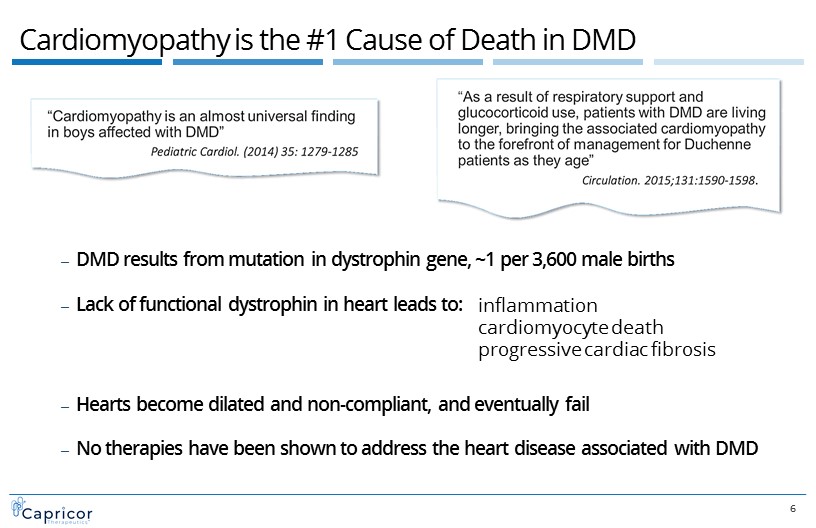
Cardiomyopathy is the #1 Cause of Death in DMD 6 ‒ DMD results from mutation in dystrophin gene, ~1 per 3,600 male births ‒ Lack of functional dystrophin in heart leads to: ‒ Hearts become dilated and non - compliant, and eventually fail ‒ No therapies have been shown to address the heart disease associated with DMD inflammation cardiomyocyte death progressive cardiac fibrosis

‒ CAP - 1002 is a biologic product consisting of allogeneic cardiosphere - derived cells (CDCs) ▪ Manufactured from donated heart muscle ▪ Does not act by “ stemness ” – the cells do not engraft into host tissue ▪ Acts by releasing extracellular vesicles, or exosomes » Contain non - coding RNAs and proteins » Internalized by target cells » Stimulate diverse and lasting changes in cellular behavior ▪ CDCs have been the subject of <100 peer - reviewed papers since 2007 ▪ CAP - 1002 has been investigated in several clinical trials and more than 130 human subjects Capricor’s Technology 7
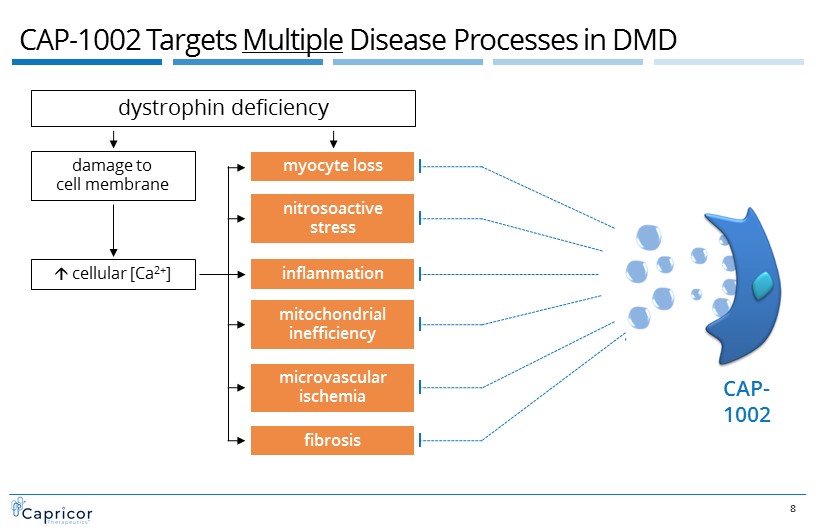
damage to cell membrane CAP - 1002 Targets Multiple Disease Processes in DMD 8 CAP - 1002 dystrophin deficiency c ellular [Ca 2+ ] myocyte loss nitrosoactive stress inflammation mitochondrial inefficiency fibrosis microvascular ischemia

Effects of CDCs in mdx Mouse Model 9 ‒ Following a single administration of CDC or vehicle to mdx mice: Aminzadeh et al, 2017 ( http://biorxiv.org/content/early/2017/04/20/128900 ). Improved cardiac function Increased exercise capacity ▪ Left ventricular ejection fraction markedly improved vs. control (p<0.05 at all timepoints through 12 weeks of follow - up) ▪ Exercise performance approximately doubled vs. control (p<0.005 at all timepoints through 12 weeks of follow - up)

Effects of CDCs in mdx Mouse Model 10 ‒ Following a single administration of CDC or vehicle to mdx mice: Aminzadeh et al, 2017 ( http://biorxiv.org/content/early/2017/04/20/128900 ). Enhanced skeletal muscle function ▪ Twitch force, tetanic force, and fibrosis in soleus (slow - twitch) and extensor digitorum longus (fast - twitch) muscles significantly improved vs. control (p<0.05; muscles isolated at three weeks post - treatment)

Physiological Effects of CDC in mdx Model 11 Oxidative Stress Fibrosis Inflammation Mitochondrial Integrity Muscle Cell Generation phospho - Akt Nrf2 (cytoplasmic) Nrf2 (nuclear) HO - 1 catalase SOD - 2 GCLC cat. sub. phospho - IkB p65 (nuclear) MCP1 CD68+ macrophages CD3+ T cells collagen I collagen III m itochondrial DNA copy number level of respiratory chain subunits RESTORED mitochondrial ultrastructure NORMALIZED deficient respiratory capacity of isolated mitochondria Ki67 + cardiomyocytes Aurora B cardiomyocytes NF - kB Adapted from Aminzadeh et al, 2017 ( http://biorxiv.org/content/early/2017/04/20/128900 ).

Phase I / II HOPE - Duchenne Clinical Trial 12 CAP - 1002 (1 x 75M cells) Usual Care n=12 25 patients Ages 12 and older DMD heart disease EF > 35% Stable steroids n=13 6 CAP - 1002 given by intracoronary infusion 12 data presented at AHA 2017 late - breaking session ▪ One - time, multi - vessel, intracoronary delivery of cells ▪ Safety trial with multiple exploratory efficacy endpoints ▪ Three U.S. sites: Cedars - Sinai Medical Center Cincinnati Children’s University of Florida https://clinicaltrials.gov/ct2/show/NCT02485938

Baseline Characteristics 13 Usual Care (n=12) CAP - 1002 (n=13) Age, median years (range) 17.5 (12 – 20) 18 (14 – 25) Wheelchair Use Always (%) 7 (58) 10 (77) Cardiac Scar Size, mean % (SD) 21.4 (10.8) 17.6 (6.8) LV Ejection Fraction, mean % (SD) 48.4 (7.5) 49.6 (6.7) Intracoronary Dose, M cells (SD) n/a 73.7 (3.6) Patients were all male, were all receiving chronic treatment with systemic steroids, and were mostly Caucasian. — HOPE population characterized by advanced disease; majority were non - ambulant — Most DMD clinical development has been conducted in less sick patients

Heart Muscle: Reduced Myocardial Scarring 14 ‒ Assessed by cardiac MRI with blinded analysis by core lab ‒ Scar increased in the Usual Care group, but decreased in the CAP - 1002 group ▪ 11.9% group difference in change score at Month 12 (p=0.03) ‒ Decreased scar is counter to the natural history of DMD p=0.09 p=0.03 Month 6 Month 12 IMPROVEMENT

Heart Muscle: Increased Regional Systolic Wall Thickening 15 ‒ Greatest evidence of improvement seen in inferior wall ‒ Similar trend in anterior wall ‒ Lesser trends in lateral and septal walls ‒ Consistent with natural history of scar progression in DMD ▪ Inferior → Anterior → Lateral → Septal ‒ No effect detected in ejection fraction ▪ Baseline EF = low end of normal range p=0.04 p=0.09 INFERIOR WALL ANTERIOR WALL Month 6 Month 12 p=0.10 p=0.54 IMPROVEMENT

Measuring DMD Progression Requires Use of Multiple Outcome Measures 16 Muscle Function ▪ 6 - minute walk test ▪ 4 - stair climb ▪ 4 - stair descend ▪ 10m walk / run Disease Progression ▪ North Star Ambulatory Assessment (NSAA) ▪ Loss of Ambulation Upper Limb Impairment ▪ Brooke / EK Scales ▪ Performance of the Upper Limb (PUL) Pulmonary Function ▪ Forced vital capacity
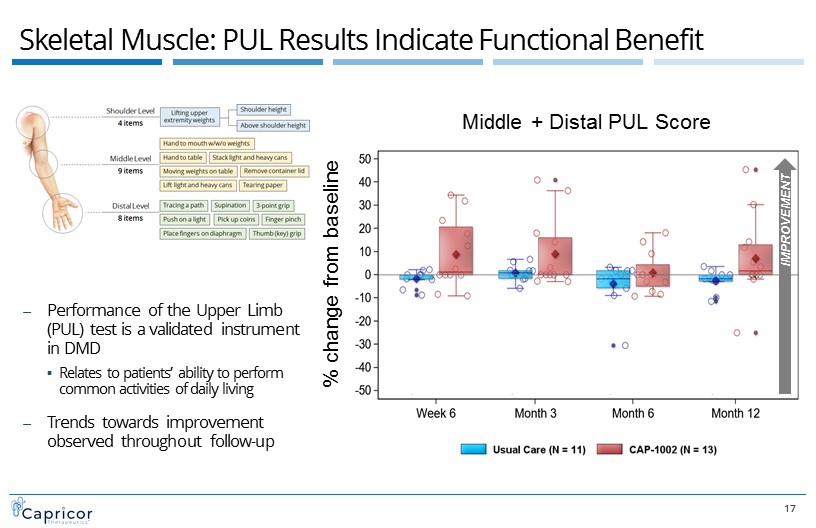
17 Skeletal Muscle: PUL Results Indicate Functional Benefit ‒ Performance of the Upper Limb (PUL) test is a validated instrument in DMD ▪ Relates to patients’ ability to perform common activities of daily living ‒ Trends towards improvement observed throughout follow - up Middle + Distal PUL Score % change from baseline IMPROVEMENT

18 Skeletal Muscle: PUL Results Indicate Functional Benefit Patients (%) ‒ Middle + Distal PUL scores ‒ Subgroup of patients with more advanced disease (baseline middle + distal PUL score < 55 of 58 max) ‒ Responder defined as: ≥ 10% improvement from baseline or max possible improvement Post Hoc Responder Analysis p=0.10 p=0.22 p=0.49 p=0.22 (n=9) (n=4) (n=9) (n=9) (n=9) (n=5) (n=6) (n=4)
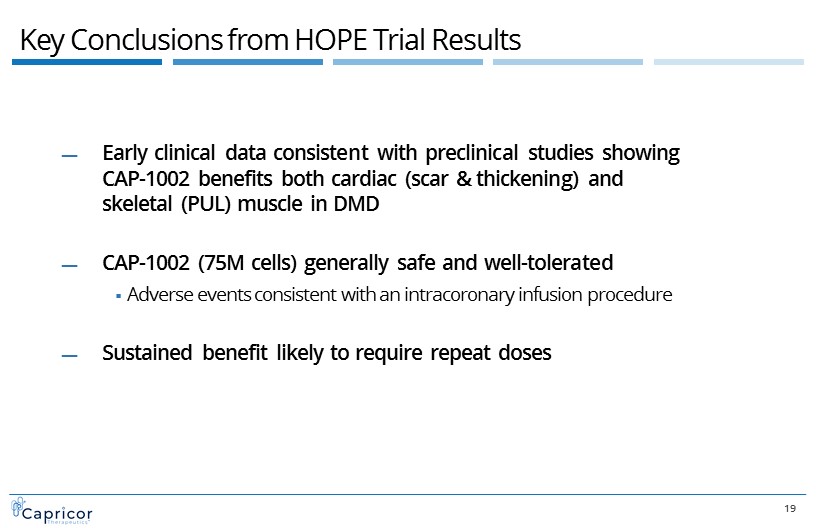
Key Conclusions from HOPE Trial Results — Early clinical data consistent with preclinical studies showing CAP - 1002 benefits both cardiac (scar & thickening) and skeletal (PUL) muscle in DMD — CAP - 1002 (75M cells) generally safe and well - tolerated ▪ Adverse events consistent with an intracoronary infusion procedure — Sustained benefit likely to require repeat doses 19

— Potential registration trial to initiate in 1Q 2018 ▪ Randomized, double - blind, placebo - controlled ▪ Target enrollment of 84 patients with advanced disease ▪ Peripheral intravenous delivery – supported by preclinical studies ▪ Repeat - dose design – potential to achieve sustained benefit ▪ Primary efficacy endpoint – difference in change in mid - PUL scores at Month 12 ▪ Principal Investigator – Craig M. McDonald, M.D. — FDA willing to consider PUL as an efficacy endpoint for registration ▪ Type B meeting held in June, following six - month HOPE data — IND 30 - day review period concluded with no clinical holds 20 HOPE - 2 Clinical Trial of CAP - 1002 in DMD
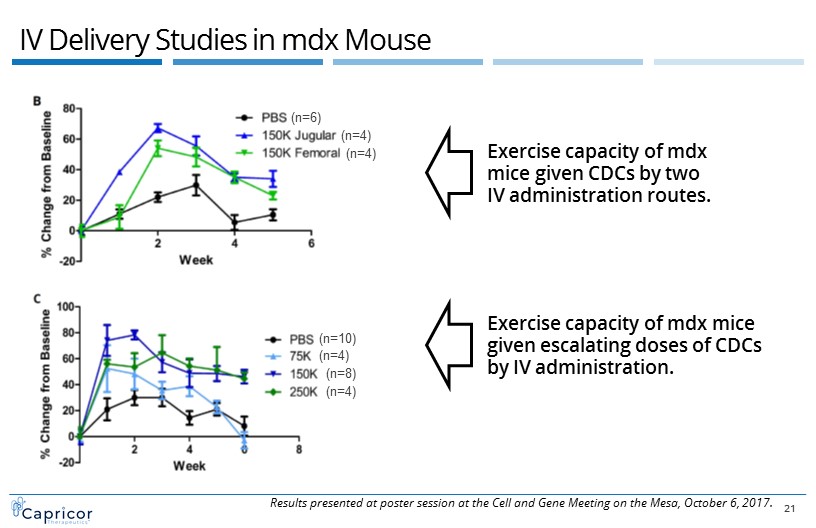
21 IV Delivery Studies in mdx Mouse Exercise capacity of mdx mice given CDCs by two IV administration routes. (n=4) (n=4) (n=6) Exercise capacity of mdx mice given escalating doses of CDCs by IV administration. (n=4) (n=8) (n=10) (n=4) Results presented at poster session at the Cell and Gene Meeting on the Mesa, October 6, 2017.
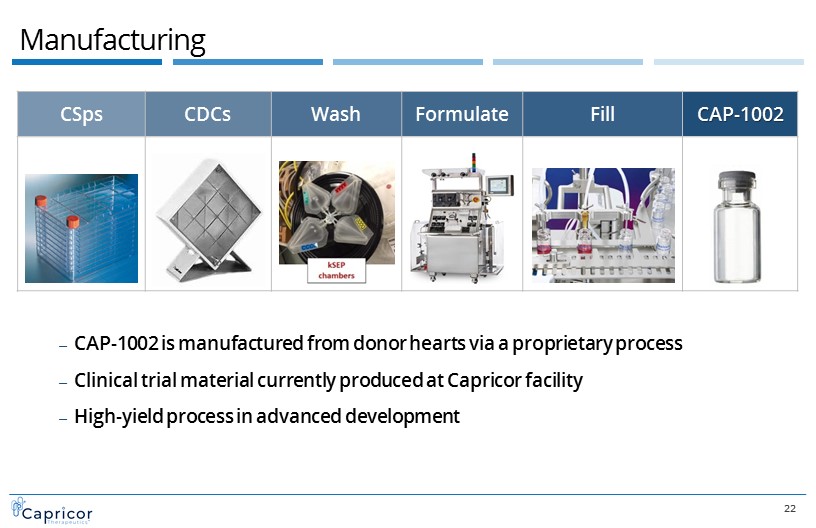
22 Manufacturing CSps CDCs Wash Formulate Fill CAP - 1002 ‒ CAP - 1002 is manufactured from donor hearts via a proprietary process ‒ Clinical trial material currently produced at Capricor facility ‒ High - yield process in advanced development

Capricor has Assembled a World - Class DMD Advisory Board 23 Barry Byrne, M.D., Ph.D. University of Florida (USA) Michelle Eagle, Ph.D., M.Sc., MCSP Atom International Ltd (UK) Richard Finkel , M.D. Nemours Children's Hospital (USA) Pat Furlong Parent Project Muscular Dystrophy (USA) Kan Hor , M.D. Nationwide Children's Hospital (USA) John Jefferies, M.D. Cincinnati Children's Hospital Medical Center (USA) Oscar Henry Mayer, M.D. Children's Hospital of Philadelphia (USA) Craig McDonald, M.D. University of California at Davis (USA) Eugenio Mercuri , M.D., Ph.D. Catholic University of the Sacred Heart (Italy) Francesco Muntoni , M.D. University College London (UK) Ron Victor, M.D. Cedars - Sinai Medical Center (USA) Thomas Voit , M.D. University College London (UK)
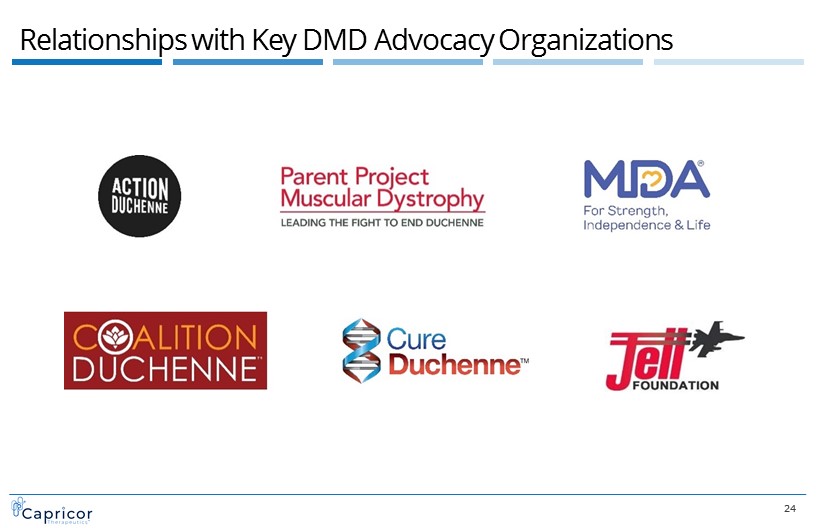
Relationships with Key DMD Advocacy Organizations 24

Resources Expected to Fund Operations Through 3Q18 25 Capricor has received over $30 million in competitive grants and a loan award from: California Institute of Regenerative Medicine National Institutes of Health U.S. Department of Defense Cash and equivalents $13.9 million (as of Sept. 30, 20 17) Shares outstanding 25.7 million (as of Nov. 10, 2017 ) Capricor reported the above information in its most recent Quarterly Report on Form 10 - Q filed with the SEC on November 14, 2017 .

Recent and Upcoming Milestones 26 4Q 2017 Presented six - month HOPE results at World Muscle Society Congress 4Q 2017 Presented 12 - month HOPE results at AHA Late - Breaking Session 4Q 2017 Announced IND clearance to conduct HOPE - 2 Trial 1Q 2018 Expect to submit request for RMAT designation for CAP - 1002 1Q 2018 Expect to initiate HOPE - 2 Trial of intravenous, repeat - dose CAP - 1002 2018 Expect to submit IND for CAP - 2003 in hypoplastic left heart syndrome
